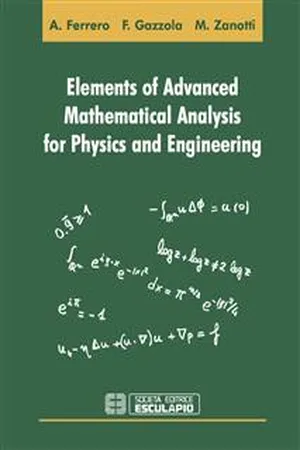
Elements of Advanced Mathematical Analysis for Physics and Engineering
- English
- ePUB (mobile friendly)
- Available on iOS & Android
Elements of Advanced Mathematical Analysis for Physics and Engineering
About this book
Deep comprehension of applied sciences requires a solid knowledge of Mathematical Analysis. For most of high level scientific research, the good understanding of Functional Analysis and weak solutions to differential equations is essential. This book aims to deal with the main topics that are necessary to achieve such a knowledge. Still, this is the goal of many other texts in advanced analysis; and then, what would be a good reason to read or to consult this book? In order to answer this question, let us introduce the three Authors. Alberto Ferrero got his degree in Mathematics in 2000 and presently he is researcher in Mathematical Analysis at the Università del Piemonte Orientale. Filippo Gazzola got his degree in Mathematics in 1987 and he is now full professor in Mathematical Analysis at the Politecnico di Milano. Maurizio Zanotti got his degree in Mechanical Engineering in 2004 and presently he is structural and machine designer and lecturer professor in Mathematical Analysis at the Politecnico di Milano.
The three Authors, for the variety of their skills, decided to join their expertises to write this book. One of the reasons that should encourage its reading is that the presentation turns out to be a reasonable compromise among the essential mathematical rigor, the importance of the applications and the clearness, which is necessary to make the reference work pleasant to the readers, even to the inexperienced ones. The range of treated topics is quite wide and covers the main basic notions of the scientific research which is based upon mathematical models. We start from vector spaces and Lebesgue integral to reach the frontier of theoretical research such as the study of critical exponents for semilinear elliptic equations and recent problems in fluid dynamics. This long route passes through the theory of Banach and Hilbert spaces, Sobolev spaces, differential equations, Fourier and Laplace transforms, before which we recall some appropriate tools of Complex Analysis. We give all the proofs that have some didactic or applicative interest, while we omit the ones which are too technical or require too high level knowledge. This book has the ambitious purpose to be useful to a broad variety of readers. The first possible beneficiaries are of course the second or third year students of a scientific course of degree: in what follows they will find the topics that are necessary to approach more advanced studies in Mathematics and in other fields, especially Physics and Engineering. This text could be also useful to graduate students who want to start a Ph.D. course: indeed it contains the matter of a multidisciplinary Ph.D. course given by Filippo Gazzola for several years at Politecnico di Milano. Finally, this book could be addressed also to the ones who have already left education far-back but occasionally need to use mathematical tools: we refer both to university professors and their research, and to professionals and designers who want to model a certain phenomenon, but also to the nostalgics of the good old days when they were students. It is precisely for this last type of reader that we have also reported some elementary topics, such as the properties of numerical sets and of the integrals; moreover, every chapter is provided with examples and specific exercises aimed at the involvement of the reader.
Frequently asked questions
- Essential is ideal for learners and professionals who enjoy exploring a wide range of subjects. Access the Essential Library with 800,000+ trusted titles and best-sellers across business, personal growth, and the humanities. Includes unlimited reading time and Standard Read Aloud voice.
- Complete: Perfect for advanced learners and researchers needing full, unrestricted access. Unlock 1.4M+ books across hundreds of subjects, including academic and specialized titles. The Complete Plan also includes advanced features like Premium Read Aloud and Research Assistant.
Please note we cannot support devices running on iOS 13 and Android 7 or earlier. Learn more about using the app.
Information













Table of contents
- Cover
- Title Page
- Copyright
- Contents
- Preface
- 1. Banach and Hilbert spaces
- 2. Lebesgue integral and Lp spaces
- 3. Classical solutions of linear partial differential equations
- 4. Complex Analysis
- 5. Integral transforms
- 6. Hilbertian Sobolev spaces
- 7. Weak solutions of linear partial differential equations
- 8. Some nonlinear partial differential equations
- Glossary of the prerequisites
- Bibliography
- Index